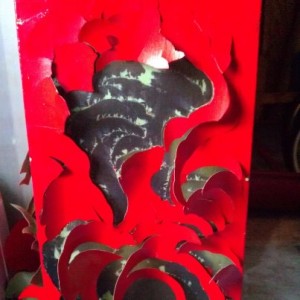So how’s YOUR insulation?
Let me start by saying I’m from New England. I’m not some wimpy Floridian or Californian who doesn’t know the meaning of winter. But in the last week or so, I feel like I’ve developed an uncomfortably intimate relationship with cold.
Last winter was my first in the North Country, and I’m well-aware that it was an unusual, and worrying, one. When my husband (who is into the cold weather, incidentally) and I visited the winter before, we’d encountered three feet of snow on the ground and bitter cold. So we were ready.
On thing that has surprised me, though, is the way the cold takes its toll on things. Our house creaks like it’s suffering; and in our garage, a piece of metal furniture suddenly and dramatically sheared off its paint earlier this week. Not to mention the frigid air that creeps around the windows, blasts from the undersink cabinet doors that we’ve left open so the pipes don’t freeze, and nuzzles me gently as I sleep if I let the comforter get even half an inch below my chin.
And we’re discovering the limits of what closing doors and windows can do. But we’re lucky. Our house is reasonably well-insulated, but a recent conversation with NCPR web manager Dale Hobson (who also blogged this week about his chilly mornings) revealed that due to the history of his house, part of it can’t be insulated — the space between the outer and inner walls is too narrow for standard insulation. Chilly.
Conclusion-drawer that I am, I find this fascinating. Ideally, we’d all have triple-pane windows and the most up-to-date insulation technology to keep us warm in the least expensive, most efficient way possible. But, as in so many things, life gets in the way — Dale, for example, is not going to save so much on heating that it makes economic sense for him to knock his house down and start again with something more energy-efficient (nor does he probably want to). We’re not going to construct a big wall in our open-plan house so it’s easier to heat. Really, the best we can all do for now is bundle up, stay warm, and try not to let our paint shear off.









Nora, it sounds like your major problem is drafts, i.e., places where air moves through your walls and windows. You might be able to make your house a lot more comfortable by stopping up some of the leaks. NYSERDA could probably give you some advice or put you in touch with a contractor who would look over your house and give you some options.
The advice about drafts is right on. You’ll have to do most of it in warmer weather but seal up all cracks and holes around the outside of your house. I lived in a 100+ year old building for years and after the first winter invested in several tubes of caulk. It made a noticeable difference. If your windows are loose you might look into the “peal-away” caulk. Run a bead around the sashes on the inside. When spring comes you can just peal it off so that you can open the window. Seal all the interior cracks and crevasses on exterior walls too. You can do that now on warmer days like the one coming Wednesday.
Any house can be insulated. It’s a question of how you do it. For example if you live in an old brick or stone house with plastered interior walls you can put up studs inside and install insulation. The trade off is that your rooms get smaller by the thickness of the studs/insulation that you install. If you have a frame house with thin walls you can pull the siding, install foam panels, house wrap to stop drafts and re-install siding. Of course neither of these are cheap but you have to weigh the one time cost against the long term cost of heating and your budget. Don’t overlook attic insulation. Heat rises.
Even in a well insulated house however you will feel the wicking effects of extreme cold and/or wind. It’s just part of living in the North Country. Wool sweaters and electric lap robes are a common line of last resort.
Just to elaborate – the way insulation works is if it stops the movement of air. You can put 8″ of fiberglass insulation in your walls, but if you don’t seal them the wind will go through them and the fiberglass will mainly act as an air filter. So sealing on the interior and exterior of the house is crucial. However, you can do a fair bit of damage if you seal in such a way that moist air gets trapped in your walls and ceilings, so it’s really a good idea to get a professional in to take a look. The increased comfort you will find in living in a well-sealed house will be worth it.
Also, wool sweaters are my favorite, more a line of first, rather than last, resort!
Super-insulated houses often have stale air. Plug up the most egregious leaks but let the house keep breathing.
As you mention your open floor plan, you may want to invest in having a masonry heater built in the center of your house. There are companies now Upstate and in Ontario and New England who specialize in them, and lots of fascinating sites that explain how they work. I would never go back to woodstoves again. Have one designed with a built-in heated bench facing a sunny window, and you’ll be waiting impatiently for the cold weather to start.
Also, yes to wool sweaters.